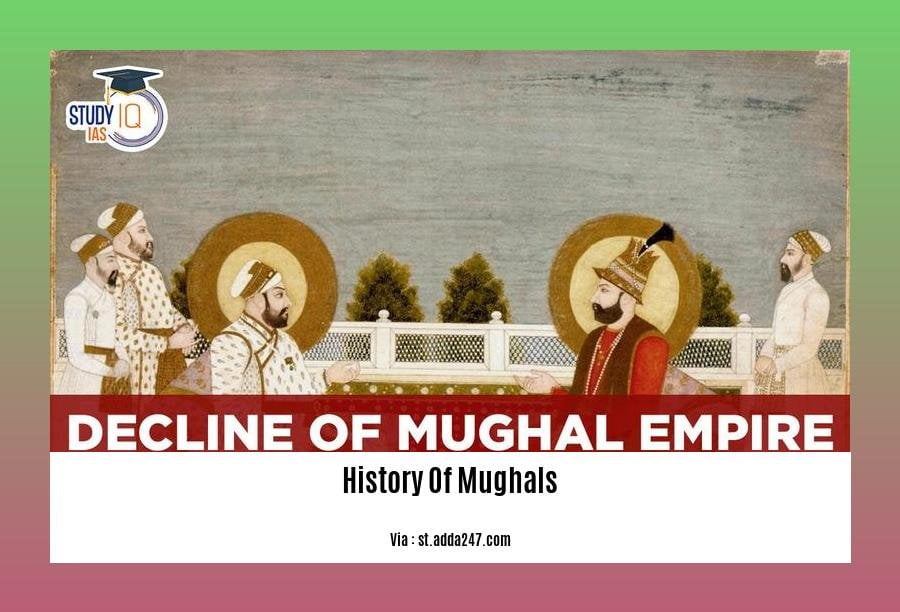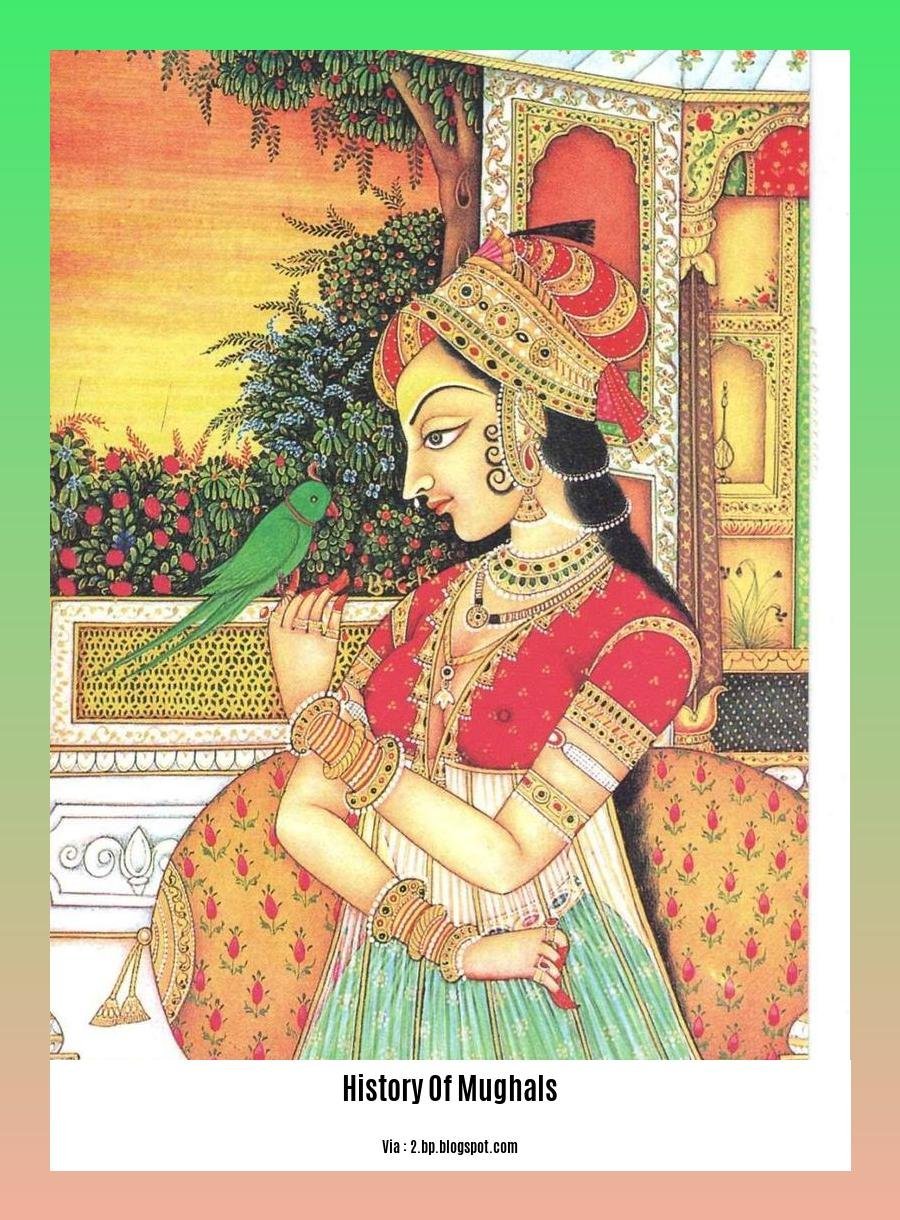[A Historian’s Perspective on the History of Mughals]: Travel back in time to explore the zenith of power and grandeur with the Mughal Empire. Their legacy, spanning over centuries, has left an indelible mark on the tapestry of Indian history.
Key Takeaways:
- The Mughal Empire, founded by Babur in 1526, reigned over a vast region extending from Central Asia to the Deccan plateau and from the Indus River to the Assamese highlands.
- The Mughal Empire implemented a bureaucratic government under Akbar, centralizing authority.
- India’s population growth accelerated during the Mughal period.
- The Mughal Empire played a crucial role in South Asian history.
- The empire’s cultural legacy continues to be evident in India, Pakistan, and Bangladesh.
History Of Mughals

Their empire stretched far and wide, from the foothills of the Himalayas to the lush Deccan plateau. They were the Mughals, a dynasty of Central Asian origin that ruled over the Indian subcontinent for over two centuries, leaving an indelible mark on its history and culture.
The Foundations
The History Of Mughals began in 1526 when Babur, a descendant of Timur and Genghis Khan, swept into India from Central Asia. A brilliant military strategist, Babur laid the foundations of the Mughal Empire, which would eventually become one of the largest and most powerful empires in the world.
The Golden Age
Under Akbar, the third Mughal emperor, the empire reached its zenith. Akbar was a visionary ruler who instituted a series of reforms that transformed the Mughal Empire into a well-oiled administrative machine. He established a centralized bureaucracy, introduced a uniform land revenue system, and promoted religious tolerance.
Akbar’s reign also witnessed a flourishing of the arts and culture. He was a great patron of architecture, and some of the most iconic Mughal monuments, such as the Taj Mahal and the Red Fort, were built during his time.
The Decline
After Akbar’s death, the Mughal Empire began a gradual decline. His successors, though capable rulers, were unable to maintain the same level of stability and prosperity. External threats, such as the rise of the Marathas and the British East India Company, also contributed to the empire’s eventual downfall.
The Legacy
Despite its decline, the Mughal Empire left a lasting legacy on the Indian subcontinent. Its administrative and revenue systems formed the basis of later Indian governments. Its architectural marvels continue to inspire awe and wonder. And its cultural achievements, such as the融合of Persian and Indian artistic traditions, have had a profound impact on South Asian culture.
Today, the History Of Mughals stands as a testament to the power, grandeur, and cultural richness of one of the greatest empires in history.
- Learn about the rich history of Mughalsarai, a city in India with a captivating past. History Of Mughalsarai
- Explore the Mughal Garden, a beautiful oasis in the heart of India, and delve into its intriguing history. Mughal Garden History
History Of Mughals Wikipedia

The history of the Mughals is a fascinating and complex one, spanning over two centuries and leaving an indelibutable mark on South Asian history. Mughals were a Muslim dynasty that ruled over large parts of South Asia from the early 16th century to the mid-19th century.
Here are some key highlights of their reign:
Established in 1526 by Babur, a descendant of Genghis Khan, the Mughals ruled over a vast empire that stretched from Central Asia to the Deccan Plateau.
Instituted a highly centralized and bureaucratic government system under Emperor Akbar, who is often considered the greatest of the Mughals.
The Mughals had a significant impact on South Asian culture and society. They were patrons of the arts and architecture, and their rule saw the flourishing of many cultural traditions, including the development of the Hindustani language and the Bhakti movement.
The Mughals also played a significant role in the history of warfare and trade. They adopted new military technologies, such as gunpowder artillery, and expanded trade networks with Europe and Central Asia.
However, the reign was not without its challenges.
The Mughals faced numerous rebellions and invasions, including those led by the Sikhs and the Marathas.
Aurangzeb’s rule is often seen as a turning point in the dynasty’s decline.
The Mughal Empire eventually declined due to a combination of factors, including internal divisions, economic problems, and external pressures from the British East India Company.
Key Takeaways
- Founded by Babur, the Mughals ruled over a vast empire in South Asia from the early 16th to the mid-19th century.
- The Mughals implemented a centralized and bureaucratic government system under Emperor Akbar, who is often regarded as the greatest of the Mughals.
- They patronized the arts and architecture, contributing to the development of South Asian cultural traditions.
- The Mughals revolutionized warfare and trade by adopting new military technologies and expanding trade networks.
- The Empire faced internal divisions, economic problems, and external pressures, eventually leading to its decline.
Citations:
FAQ
Q1: Who founded the Mughal Empire?
A1: Babur, a Central Asian ruler from Uzbekistan, established the Mughal Empire in 1526.
Q2: What was the geographical extent of the Mughal Empire?
A2: The Mughal Empire encompassed a vast territory, stretching from northern Afghanistan to the Deccan plateau and from the Indus basin to the Assamese highlands.
Q3: What was the governing system of the Mughal Empire?
A3: The Mughal Empire implemented a highly centralized and bureaucratic government, with authority primarily concentrated in the hands of the emperor.
Q4: How did the Mughal Empire contribute to population growth in India?
A4: During the Mughal period, India’s population witnessed significant growth, likely due to improved agricultural practices and increased urbanization.
Q5: What was the cultural impact of the Mughal Empire?
A5: The Mughal Empire played a pivotal role in shaping the cultural landscape of South Asia, leaving a lasting legacy in the architectural marvels, artistic creations, and literary works that continue to inspire today.
- Unlock Water’s Symbolism: A Cross-Cultural Exploration - April 20, 2025
- Identify Black and White Snakes: Venomous or Harmless? - April 20, 2025
- Unlocking Potential: Origins High School’s NYC Story - April 20, 2025















